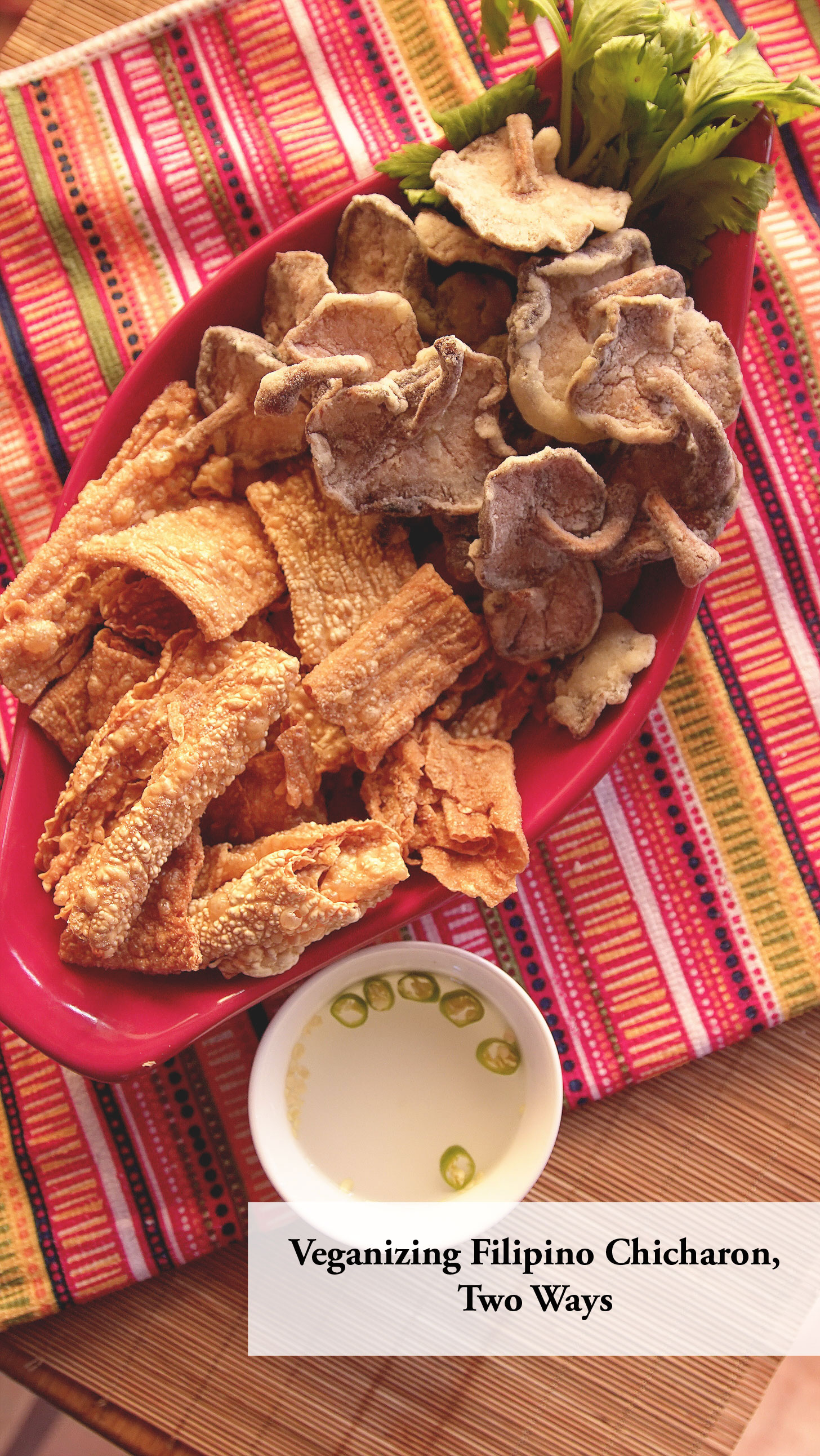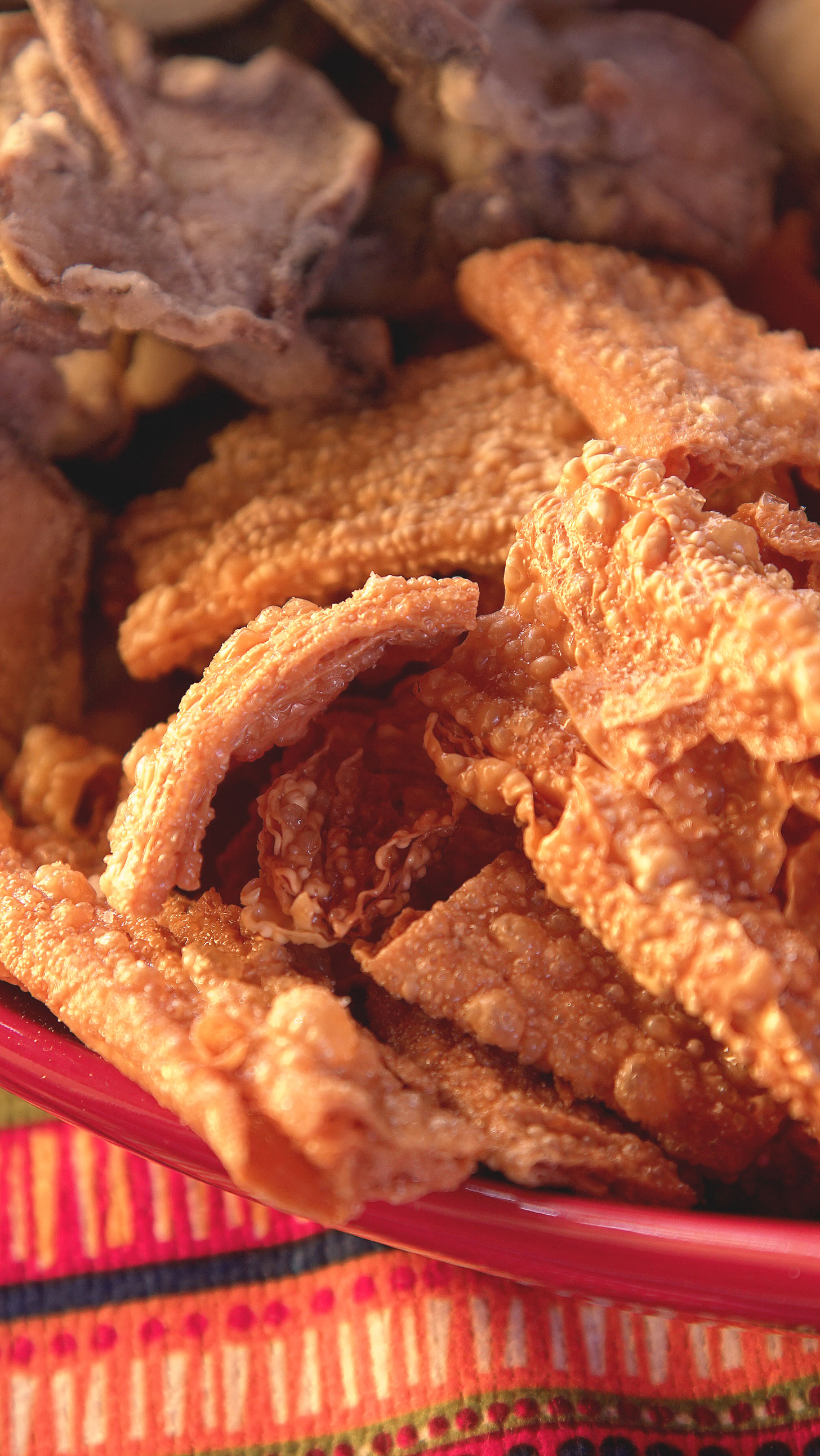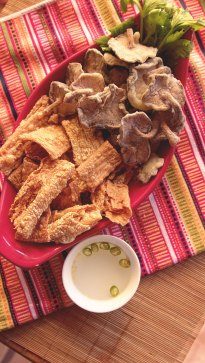
Vegan Filipino Chicharon is a fun little snack that has dried shiitake mushrooms coated in rice flour and sweet rice flour then deep-fried. Another way to make it is by deep-frying dried yuba skin. You could serve vegan Filipino Chicharon as a snack, appetizer, or party food. For best results, I suggest serving them with spicy vinegar on the side. In fact, I recently served vegan Filipino Chicharon with vinegar and my friends said they enjoyed this combo.
Traditionally, Chicharon uses fried pork rinds. Filipino street vendors would peddle their way in and around the neighborhood. Patrons would usually enjoy them as snack paired with alcoholic drinks, usually beer. In Tagalog, we call this beer and snack pairing, “pulutan”.
Veganizing pork rinds may seem like rocket science, but really, it’s very simple that I offer you not just one, but two simple ways on how to do it. Actually, make that three because I have already posted a Chicharon recipe before but with snow fungus or tremelle. So now you have three easy recipes to choose from!

Lately, I notice on social media a spur of wonderful vegan products and services in the Philippines. These vegan businesses are really upping up their game. Two of the most popular vegan Filipino products are the cleverly named “Chicha-shroom” (made of shiitake mushrooms) and “Sea-charon” (made of seaweed). I did hear raving, positive reviews about these two Chicharon products.
For now, I offer you my version. It’s simple enough that anyone can make this (although I advise you to supervise kids when deep-frying). You might say that it’s very similar to my vegan Calamari version. To that I would say, very very similar indeed except this Chicharon recipe does not need any breadcrumbs or cornmeal, nor any non-dairy milk. So if you think the vegan Calamari was a simple recipe, wait until you try this one. It couldn’t get any simpler!
- For the mushroom chicharon
- 1½ cup dried shiitake mushrooms, whole or sliced
- bowl of hot water
- ¼ cup rice flour
- ¼ cup sweet rice flour aka glutinous rice flour
- sea salt
- canola oil
- spicy vinegar for dipping (optional)
- For the yuba chicharon
- 1½ cup dried bean curd stick, cut or broken into different sizes
- sea salt
- canola oil
- spicy vinegar for dipping (optional)
- Reconstitute dried mushrooms by submerging them in hot water. The amount of water doesn't have to precise, as long as the mushrooms are soaking in it. Alternatively, you could microwave a bowl of mushrooms and water for 3-5 minutes. Let the mushrooms soften for about 10 minutes. Remove mushrooms from the broth. You could save the broth for another dish like in making soups and sauces.
- Fill a small pot with about two inches of oil. Heat over high heat for 5-8 minutes.
- In a separate bowl, combine two kinds of flour - rice and sweet rice flour. See notes below about the difference between the two.
- If using a frying thermometer, aim for 375 degrees. If you don't have a thermometer, you could test if the oil is ready by frying one piece of coated mushroom. Coat one piece of mushroom in flour and fry in oil. If mushroom bubbles, the oil is ready. If it hasn't yet, wait for another minute or two then test again. If the mushroom is bubbling too vigorously as if boiling, your oil is too hot. Turn down heat or even turn off heat and wait for another minute or two and test again. Watch video below if you'd like to see what it's supposed to look like.
- Once oil is ready, coat mushroom and fry until slightly golden, about 1-2 minutes.
- Remove mushroom from oil and serve on paper towel-lined plate to drain excess oil.
- Season with salt. You could also use other kinds of seasoning such as garlic powder, vegetable broth powder, seaweed flakes, etc. Feel free to have fun with it!
- Serve hot with spicy vinegar on the side (suggested serving).
- Cut dried yuba in smaller pieces, size doesn't have to be precise. The dried yuba does NOT have to be reconstituted.
- Fill a small pot with about two inches of oil. Heat over high heat for 5-8 minutes.
- Test if the oil is ready by dropping a piece of yuba in the pot. If it bubbles, the oil is ready. If it hasn't yet, wait for another minute or two then test again. If the yuba is bubbling too vigorously as if boiling, your oil is too hot. Turn down heat or even turn off heat and wait for another minute or two and test again. Watch video below if you'd like to see what it's supposed to look like.
- Once oil is ready, fry the yuba for 20-30 seconds. Transfer yuba to a serving plate.
- Season with salt. You could also use other kinds of seasoning such as garlic powder, vegetable broth powder, seaweed flakes, etc. Feel free to have fun with it!
- Serve hot with spicy vinegar on the side (suggested serving).
What is sweet rice flour? Sweet rice flour, also called glutinous rice flour, is flour from sticky rice while regular rice flour is from regular white rice. The difference is most notably in the texture. Sweet rice flour will have a chewier bite. In fact, sweet rice flour is what's used in making mochi.
What is dried bean curd stick? It's a dried soy product that could be easily found at Asian grocery stores. It also goes by dried yuba skin. I based the yuba chicharon recipe from vietworldkitchen.com, although I use dried bean curd stick instead of dried bean curd sheets. The sticks give a better crunch. I find the sheets almost wafer-like, which is too light for my preference.
What is spicy vinegar? It's usually white vinegar spiced with chili pepper. Some filipino dishes like Chicharon, uses spicy vinegar as condiment or dipping sauce. The term spicy vinegar is very loose and could be adapted in many ways. You could use any kind of vinegar (coconut, cane, etc) and any kind of pepper (thai chili, jalapeno, serrano). You could also easily buy chili pepper-infused vinegar at most Asian grocery stores or online. Aside from chili pepper, you could also combine your vinegar with other kinds of spicy ingredients like hot sauce (tabasco, sriracha, etc) or ground pepper (black, cayenne, etc). The sky's the limit!
To watch how the recipe unfolds, here’s the video version on YouTube:
Yes, the Astig Vegan Cooking Show on YouTube is back! I hope you enjoy the new episodes and find them useful! Please feel free to subscribe or share your feedback. After all, this show is for you! Kain na, let’s eat!
SHOP THE RECIPE:
What’s rice flour and sweet rice flour? Learn more about these two ingredients.
Want another version of Vegan Chicharon? Try Snow Fungus Chicharon.
Want similar similar recipes? Try Vegan Calamari and Beer-Battered Kangkong.
